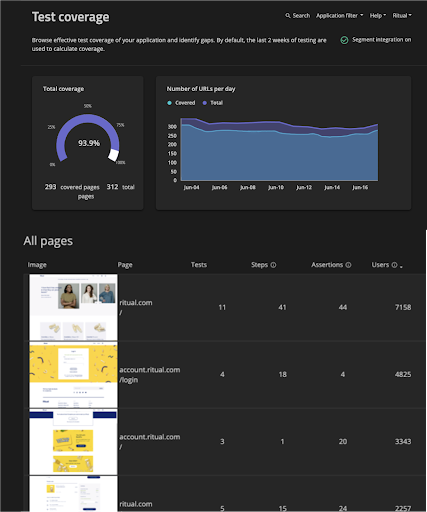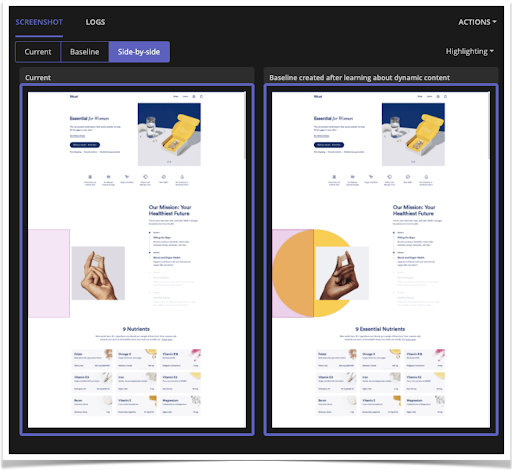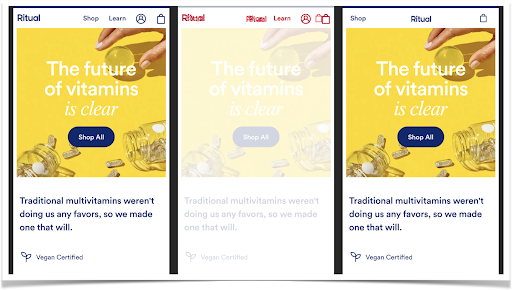Quality plays a big role in how many enterprises operate and build their products. At Ritual, quality is at the core of our brand and a big part of the reason we built our company in the first place.
You see, Ritual is a health-meets-technology company that reinvented the multivitamin from the ground up. We pride ourselves on challenging the status quo with our traceable, high-quality, and evidence-based nutrients backed by the first visible supply chain of its kind. Bottom line: we are obsessed with quality - in all facets of our business. Our multivitamins, of course, but also our website and customer experience. Since we sell our products direct-to-consumer on Ritual.com, creating a high quality ecommerce customer experience is a crucial and essential part of our company.
Preparing for a big launch
We recently launched a highly-anticipated line of men’s multivitamins that expanded our reach and relevance. To prepare for this launch, all aspects of the company needed to be on the same page to ensure a successful roll-out, including the software development team. Our technology stack doesn’t just revolve around ecommerce — it empowers our company to move quickly, iterate on our marketing efforts, and deliver a seamless customer experience. We knew technology would be at the core of this launch and we needed to be prepared.
I lead our small, but mighty QA team here at Ritual. I’m responsible for overseeing testing across the entire digital product team. I define what quality looks like on our ecommerce platform and promote it across the entire organization, as well as give the company the tools it needs to uphold that standard effectively. In the context of our men’s product launch, I knew we would have to do a lot of prep work in order to meet these high quality standards.
We had some issues to tackle right out of the gate. For starters, our entire company was operating remote due to the COVID-19 pandemic, which added communication challenges to our cross-functional process. In addition, we were faced with rapidly evolving schedules and priorities. The timeline given to the digital team was aggressive and required UX testing and increasing additional complexity, which meant we were constantly trying to keep up. As the user journey evolved, architecture changes made (or even planned) became irrelevant. To handle the complexity of this situation, we relied heavily on our intelligent testing platform, mabl.
Testing with purpose and speed
The first thing we did in preparation for the launch was scaling testing/load testing. We needed to test concurrency limits and ultimately, ended up increasing concurrency to handle transaction volume as part of mabl’s findings. This helped us identify resource bottlenecks in our configuration that may have caused days-long delays if shipped to production. The concurrency limits were increased and the project was deployed successfully, paving the way for our men's launch a month later.

Mabl’s integration with Segment allows us to prioritize test runs based on changing site traffic and page complexity.
As we tackled the launch’s evolving priorities, we used mabl’s visual change detection to gracefully handle changing copy that was regularly altered by our product and marketing teams. This AI-driven screenshot comparison runs passively in the background when running mabl tests, helping us quickly spot unwanted UI changes and proactively identify issues with minimal effort from our small team.

Mabl’s visual regression detection flags, an issue where the yellow circle was not present on a product page.
As a distributed team, QA was frequently context switching between testing feature work and testing updates made by internal teams; no easy task for a team of two. When copy changes were made by other internal teams, they were often identified by mabl visual regression detection, so we were able to stay up-to-date on changes even when we weren't explicitly notified. Branching logic also made testing incremental feature roll-outs much easier because our feature flagging platform (Optimizely) integrates seamlessly with mabl.

Mabl highlighting the visual delta between a previous cart feature and the current state in the nav. We were able to amend the flag logic based on this finding.
As we worked to meet impending deadlines, turnaround time from design to engineering became shorter and shorter. We used mabl’s visual regression detection to help us detect issues, especially when changes were made without QA, which helped us stay ahead of a fast-moving project.
I’m happy to say that this work culminated in a successful roll-out of our new Essential for Men’s multivitamins. At the end of the day, mabl was able to scale with the magnitude of our men’s multivitamin launch and enable our small team to do the work of one double its size. Throughout this launch process, we found that mabl acted as a force multiplier. Although there are only two dedicated testers on our QA team, mabl helped us get a lot more done—and be confident in our approach.
Click here to read more about Ritual’s success story.
Want to see for yourself how mabl can help you improve test coverage? Start your free trial today!






